BIO 353 - Exam 2A Key Cell Biology Spring 2019
Document Content and Description Below
BIO 353 - Cell Biology Spring 2019 Exam 2 (100 points) Version A Part 1: Membrane Structure and Function 1. Which ONE of the following is a function of the plasma membrane? a. Bre... aks down lipids, carbohydrates, and proteins from foods b. Stores water, salt, proteins, and carbohydrates c. Keeps the cell wall in place d. Regulates which materials enter and leave the cell 2. Which ONE of the following is TRUE regarding cell membranes? a. Cell membranes are inflexible due to the presence of protein molecules b. Cell membranes allow substances to pass through only by active transport c. Cell membranes are relatively impermeable to large water-soluble molecules due to the presence of the lipid bilayer d. Cell membranes contain cholesterol molecules which can act as cell receptors 3. Which ONE of the following statements is FALSE regarding phospholipids in the plasma membrane? a. The polar heads face outward and are hydrophobic b. The non-polar tails face inward and are hydrophobic c. The phospholipids form a bilayer d. Every cell membrane is made of phospholipids 4. The terms phosphatidyl choline and phosphatidyl ethanolamine refer to membrane lipids that differ in their . a. fatty acids b. polar group c. backbone molecule d. overall polarity 5. True or false: Phosphlolipids in a lipid bilayer commonly rotate around their long axis. a. True b. False 6. In general, increasing the number of double bonds in the fatty acid tails of a phospholipid . a. decreases membrane fluidity. b. increases membrane fluidity. c. decreases their lateral mobility in the membrane d. increases the likelihood of their flipping from one leaflet to the other. 7. Which ONE of the following statements is FALSE regarding cholesterol? a. Cholesterol can increase membrane fluidity by pushing apart phospholipids. b. Cholesterol can decrease membrane fluidity by restricting phospholipid movement. c. Cholesterol can damage a cell membrane by disrupting membrane proteins. d. Cholesterol can be inserted in between phospholipids in a membrane. 8. How is the mobility of membrane proteins most often restricted? a. Binding to membrane phospholipids. b. Binding to groups of carbohydrates. c. Binding to cholesterol. d. Binding to proteins inside the cell. 9. Carbohydrates in a membrane . a. normally project towards the cytoplasm. b. normally project towards the extracellular environment. c. play no role in the function of the membrane. d. are randomly joined to lipids or proteins. 10. Which ONE of the following is a major function of the carbohydrate group associated with plasma membranes? a. cell-cell recognition. b. ATP formation. c. binding of specific hormones. d. enzyme catalysis 11. True or false: Some membrane proteins are enzymes a. True b. False Questions 12 and 13 refer to the following figure showing the activity of a protein that can flip lipids from one side of a membrane to the other. 12. What is one important consequence of the activity of the protein shown above? a. The membrane is unstable and has no consistent lipid composition. b. Cellular membranes typically contain only one type of phospholipid. c. The two leaflets of the bilayer contain only one type of phospholipid. d. The two leaflets of the bilayer contain different sets of phospholipids. 13. What type of protein is shown in the image above? a. Transmembrane and Peripheral b. Peripheral and Integral c. Transmembrane and Integral d. Lipid-Linked 14. What is the role of the cell cortex in red blood cells? a. It links together channel proteins required for transport of ions into the cell b. It provides strength and helps stabilize the cell membrane c. It contains heme and allows the cell to carry oxygen d. It interacts with carbohydrates on the surface of infected cells Part 2: Transport across Cell Membranes 15. Which of the following molecules can normally cross a phospholipid bilayer by simple diffusion? a. Glucose b. ATP c. Ca2+ d. CO2 Questions 16 and 17 refer to the following figure showing a transport protein that is moving a molecule (solute) across the membrane and into the cell. 16. Which type of membrane transport illustrated in the image above? a. Simple diffusion b. Facilitated diffusion c. Active transport d. An ATP-driven pump. 17. What causes the conformation of the protein to change during the action of this transport system? a. ATP binding b. ATP Hydrolysis c. Binding of the solute d. Magic 18. During the uptake of glucose by the intestinal membrane symporter, . a. both glucose and Na+ enter the cytoplasm. b. glucose enters the cytoplasm as Na+ moves out of the cell. c. glucose enters the cytoplasm as Na+ becomes bound to the plasma membrane. d. only glucose moves across the membrane. 19. Which of the following best summarizes the activity of the voltage-gated sodium channels during an action potential? a. closed open closed inactivated b. closed open inactivated closed c. open closed open inactivated d. closed inactivated open closed Questions 20 and 21 refer to the following diagram of an action potential. 20. What causes depolarization of the membrane? a. Movement of Na+ out of the cell b. Movement of Na+ into the cell c. Movement of K+ into the cell d. Movement of K+ out of the cell 21. What is occurring during the repolarization phase of an action potential? a. Voltage-gated Na+ channels are inactive; Voltage-gated K+ channels are open b. Voltage-gated Na+ channels are inactive; Voltage-gated K+ channels are closed c. Voltage-gated Na+ channels are open; Voltage-gated K+ channels are open d. Voltage-gated Na+ channels are open; Voltage-gated K+ channels are closed 22. A new drug has been discovered that will prevent repolarization in cells. What is the most likely target of this drug? a. Na+-K+ Pump b. K+ Leak Channels c. Voltage gated Na+ Channels d. Voltage gated K+ Channels 23. Bacteriorhodopsin is a photosynthetic protein in the salt-loving archaeon, Halobacterium salinarum. It uses energy from green light to pump protons across a membrane. What drives the transport of ions across the membrane through bacteriorhodopsin? a. Hydrolysis of ATP b. Hydrolysis of GTP c. Light-activated conformational change of the prosthetic group, retinal d. Movement of protons (H+) down its concentration gradient Questions 24 and 25 refer to the following figure: 24. What type of transport is shown in the figure above? a. Facilitated diffusion b. Active transport c. Osmosis d. Simple diffusion 25. Which one of the following statements best describes the protein shown above? a. It is automatically inactivated following an action potential. b. It increases the concentration of extracellular K+ ions. c. It helps to establish the resting membrane potential. d. It is located on the lysosome membrane. 26. What class of membrane pump is indicated by letter B shown in the figure below? a. V-Class ATPase b. P-Class ATPase c. F-Class ATPase d. ABC transporter Questions 27-28 refer to the following figure of a nerve synapse: 27. Which ONE of the following most directly triggers the release of neurotransmitter from the presynaptic cell? a. The entry of neurotransmitter into the presynaptic cell. b. The closing of ligand gated Na+ channels. c. The opening of voltage-gated Na+ channels. d. The opening of voltage-gated Ca2+ channels. 28. Ion channels in the postsynaptic cell membrane that open in response to neurotransmitter binding are an example of . a. Ligand-Gated Ion Channels b. Stress-Gated Ion Channels c. Voltage-Gated Ion Channels d. ATP-Gated Ion Channels 29. Which ONE of the following best describes that actions of an excitatory neurotransmitter on a postsynaptic cell? a. Neurotransmitters enter the postsynaptic cell through neurotransmitter channels b. Neurotransmitters bind to ligand-gated ion channels to stimulate an action potential in the postsynaptic cell c. Neurotransmitters bind to ligand-gated ion channels to decrease the probability of an action potential in postsynaptic cells d. Neurotransmitters are only active in presynaptic cells 30. Ca2+ pumps in the sarcoplasmic reticulum membrane of muscle cells are important for . a. Stimulating a muscle contraction by removing Ca2+ from the cytosol b. Preventing Ca2+ from continuously activating proteins required for muscle contractions c. Providing enzymes in the sarcoplasmic reticulum with Ca2+ ions that are necessary for their catalytic activity d. Maintaining a negative membrane potential Part 3: Protein Sorting 31. What is a signal sequence? a. Small proteins that direct other proteins to the appropriate location in a cell b. A series of post-translational modifications that are added to proteins before they are transported c. A carbohydrate layer that coats the surface of proteins and helps them to stick to target membranes d. A sequence of amino acids that determines the cellular localization of a protein 32. Predict what would happen if a nuclear localization sequence on a protein was removed and replaced with a mitochondrial signal sequence. a. The protein would get transported into the nucleus b. The protein would get transported into a mitochondrion c. The protein would remain in the cytosol d. The protein would get degraded by the proteasome 33. Huntington’s disease (HD) is a neurodegenerative disease associated with decreased mitochondrial function. Proteins in HD mice are able to cross the outer mitochondrial membrane, but are unable to cross the inner mitochondrial membrane. What is the most likely cause of this defect? a. HD mice lack a functional TIM complex b. HD mice lack a functional TOM complex c. The proteins lack a mitochondrial signal sequence d. HD mice lack a functional signal recognition particle (SRP) 34. In addition to an ER signal sequence, transmembrane proteins require to be embedded into the membrane. a. Additional receptor proteins b. Additional translocase proteins c. Chaperone proteins d. Internal signal sequences 35. Which one of the following processes is unique to transport of proteins into the endoplasmic reticulum? a. It requires two translocase proteins. b. It transports the protein as it is being translated by ribosomes. c. It requires chaperone proteins to fold the cargo protein. d. It cleaves the signal sequence once the protein has been transported. Questions 36-37 refer to the following figure showing transport of cargo into the nucleus. 36. Cargo proteins are identified for transport into the nucleus because they contain: a. A specific amino acid sequence called the nuclear localization signal (NLS) b. A specific three-dimensional conformation called the nuclear localization sequence (NLS) c. The specific amino acids Serine-Lysine-Leucine. d. GTP bound to them. 37. What causes the cargo protein to be released inside the nucleus? a. It cannot pass back through the nuclear pore complex. b. The NLS gets removed. c. GDP-Ran binds to the cargo. d. GTP-Ran binds to importin. 38. Which protein is required to select and bind to specific molecules that will be packaged into vesicles? a. Cargo receptor b. Adaptin c. Clathrin d. Dynamin 39. Which one of the following protein families is NOT involved in directing transport vesicles to the target membrane? a. SNAREs b. Rabs c. Adaptins d. Tethering proteins 40. Which one of the following proteins is found on the surface of transport vesicles and is required for the vesicle to fuse to target membranes? a. V-SNARE b. T-SNARE c. Tethering protein d. Adaptin 41. During exocytosis, integral proteins facing the interior of a vesicle are . a. released into the surrounding medium. b. incorporated into the plasma membrane so that they face the cytoplasm. c. incorporated into the plasma membrane so that they face the extracellular space. d. released back into the cytoplasm. 42. Which of the following choices reflects the appropriate order through which a protein destined for the plasma membrane travels? a. ER → Golgi → plasma membrane b. lysosome → endosome → plasma membrane c. ER → lysosome → plasma membrane d. Golgi → lysosome → plasma membrane 43. The process of engulfing a bacterium with a portion of the plasma membrane is called . a. Exocytosis b. Pinocytosis c. Phagocytosis d. Cytokinesis Part 4: Introduction to Cell Signaling 44. A protein that is regulated by the binding and hydrolysis of GTP will normally be inactive when . a. ATP is bound. b. GTP is bound. c. GDP is bound. d. inorganic phosphate is bound. Question 45 refers to the following image depicting the structure of fluticasone, commonly known as Flonase. Flonase is a drug used to treat allergies. 45. Based on the chemical structure shown above, fluticasone likely acts by binding to receptors in the . a. plasma membrane b. nuclear envelope c. smooth endoplasmic reticulum d. cytosol 46. Cells that do not receive any kind of chemical signal will . a. Survive b. Die c. Grow d. Differentiate 47. In general, how are phosphorylation cascades typically turned OFF? a. Inhibitor proteins bind to and inactivate the kinases b. Phosphatases remove the phosphates c. Phosphate groups attract repressor proteins d. The secondary messengers are degraded. 48. Why are protein kinases and phosphatases essential to a cell? a. They are enzymes that destroy damaged proteins. b. They help turn proteins on and off through modification of their phosphorylation status. c. They catalyze the formation and destruction of hormones. d. They catalyze the formation of secondary messengers. Questions 49-50 refer to the following figure of an action potential. 49. What is one way by which the signaling pathway above can be turned OFF? a. The G protein can be inactivated by GTP hydrolysis b. The mitochondria can stimulate receptor inactivation c. The signal can be taken up by the cell that produced it. d. The secondary messenger, cAMP, can be degraded 50. The figure above is an example of . a. Autocrine signaling b. Juxtacrine signaling c. Synaptic signaling d. Apocrine signaling [Show More]
Last updated: 1 year ago
Preview 1 out of 16 pages
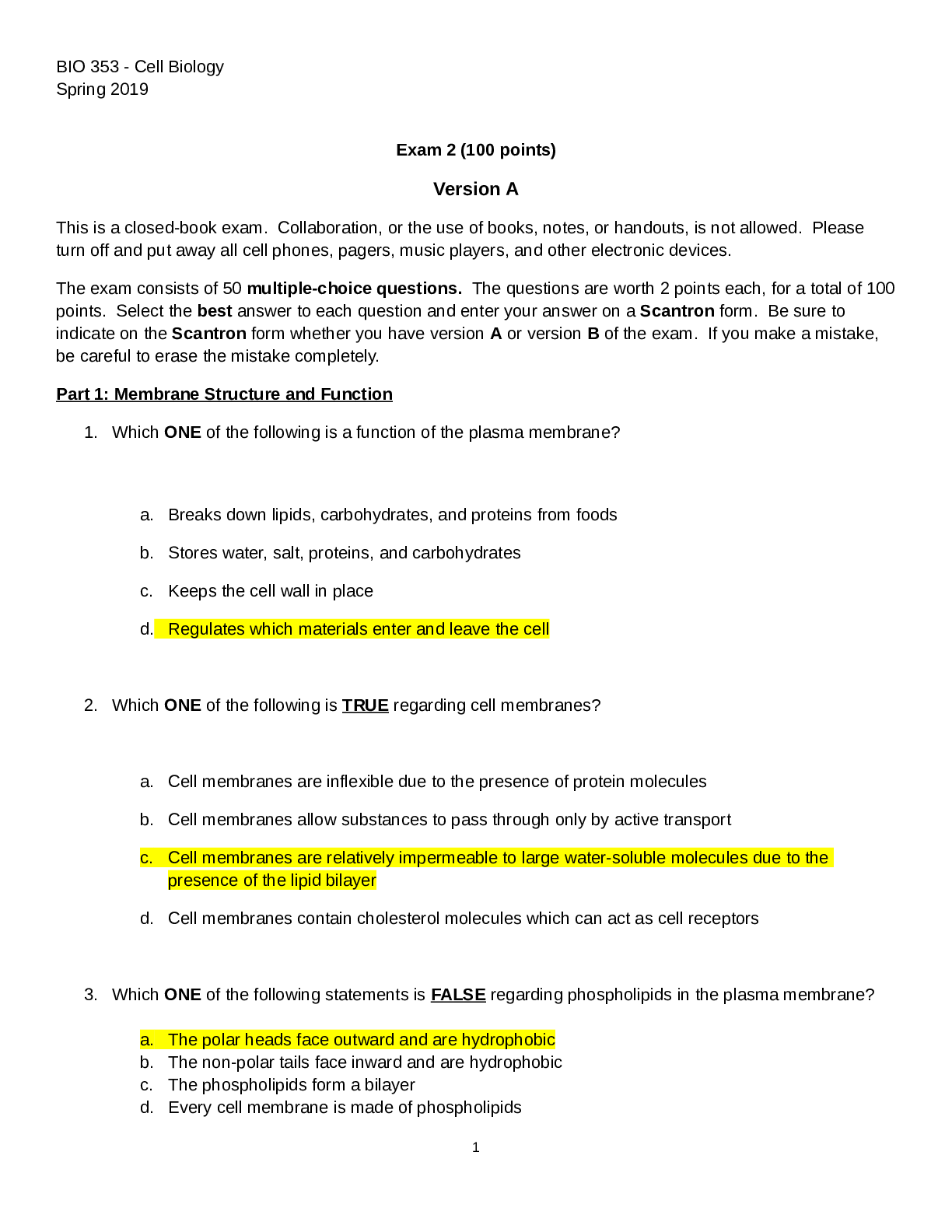
Buy this document to get the full access instantly
Instant Download Access after purchase
Add to cartInstant download
We Accept:

Reviews( 0 )
$14.00
Document information
Connected school, study & course
About the document
Uploaded On
Apr 01, 2021
Number of pages
16
Written in
Additional information
This document has been written for:
Uploaded
Apr 01, 2021
Downloads
0
Views
50




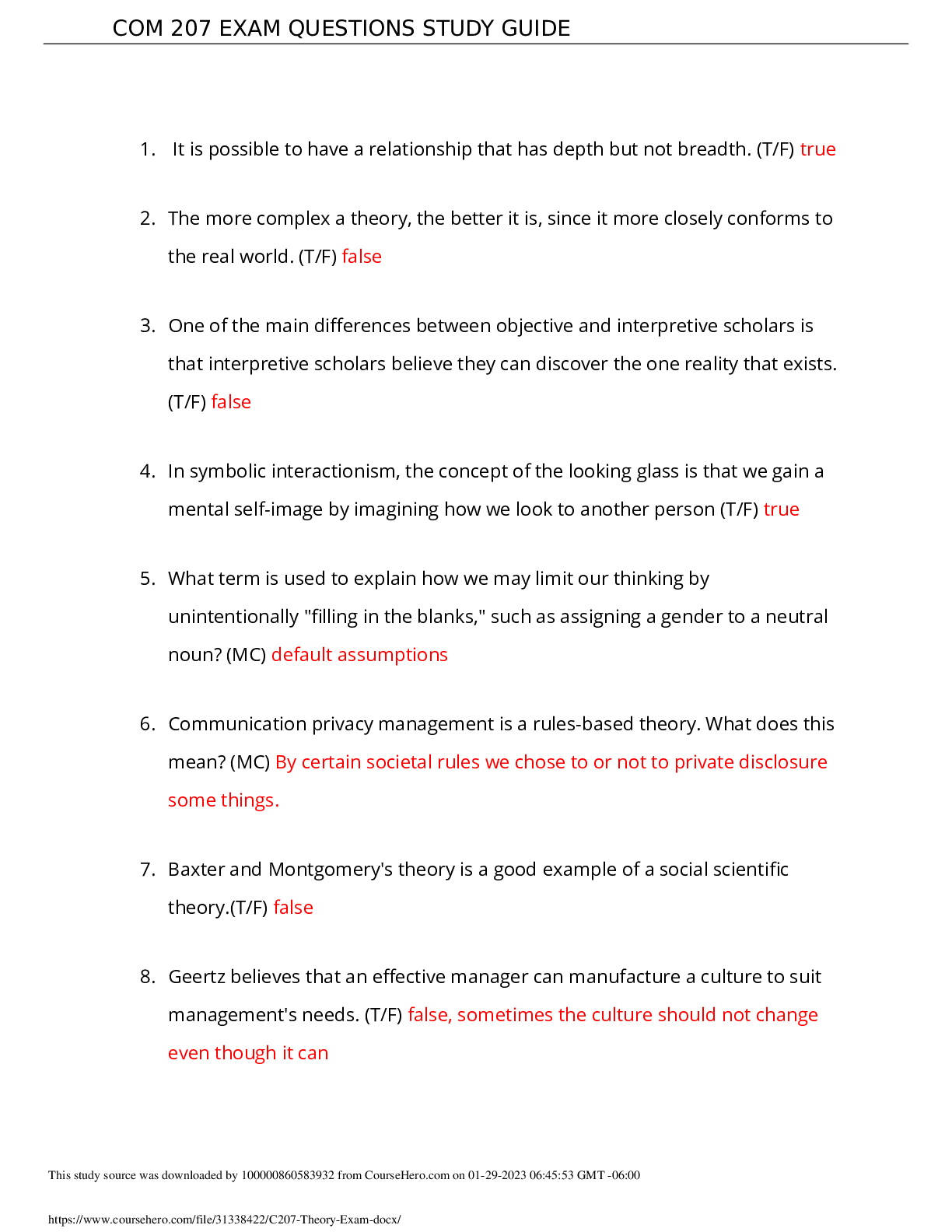
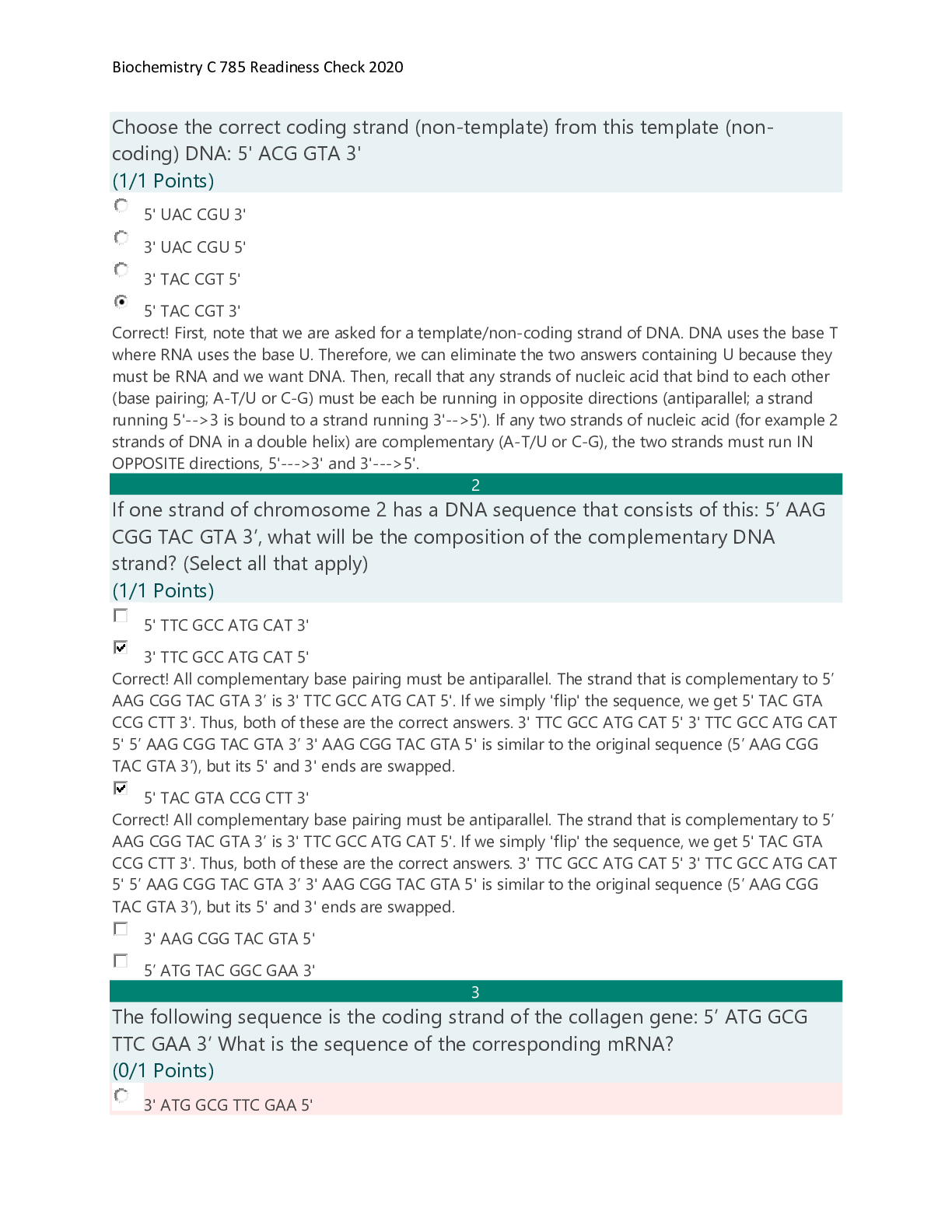
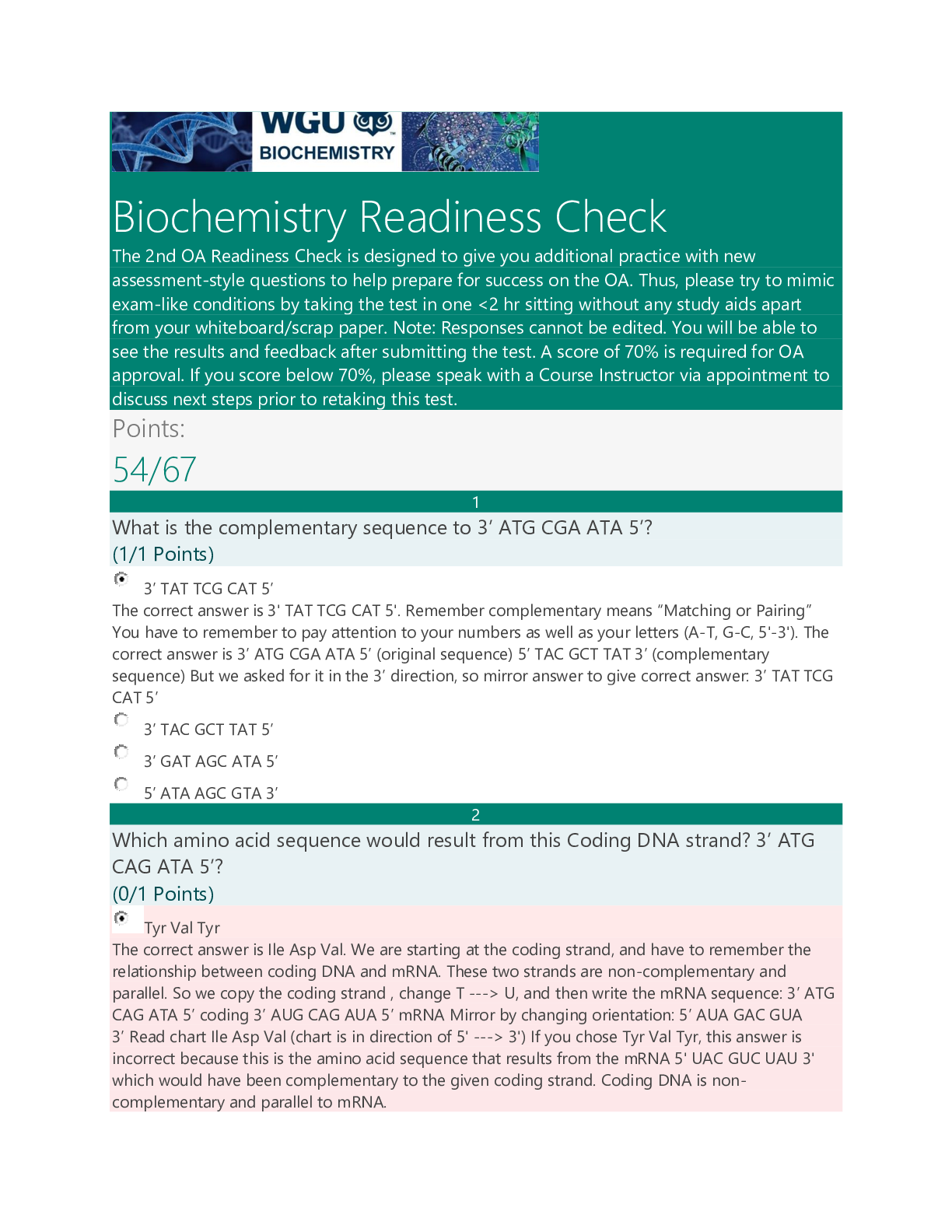


.png)

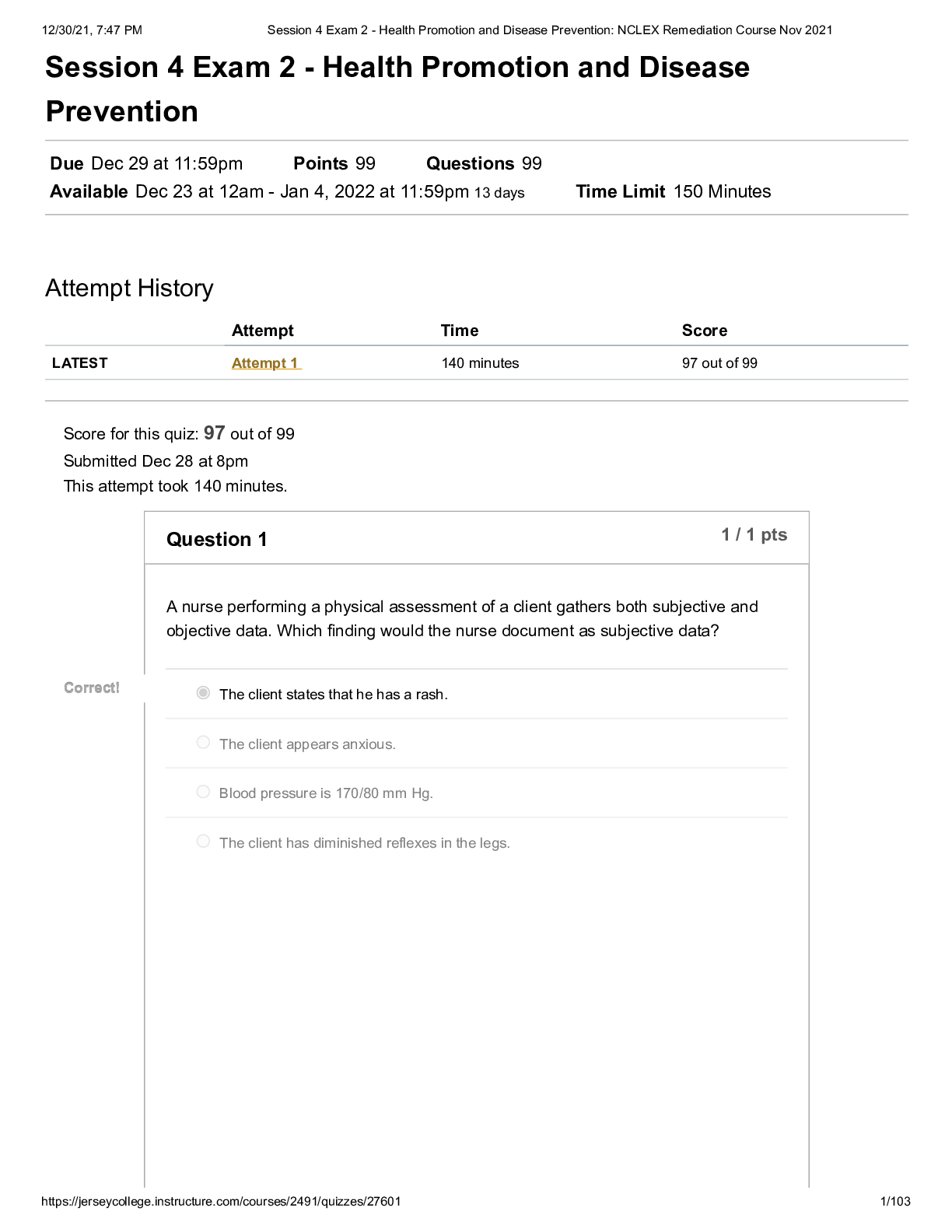
 ORGMED ORGANIC PHARMACEUTICAL PHARMACY.png)

